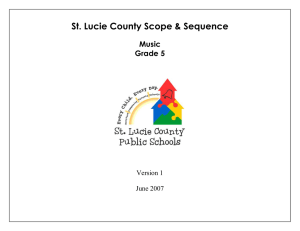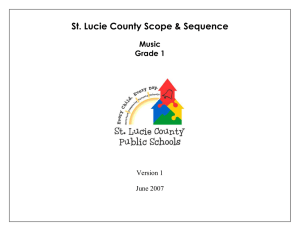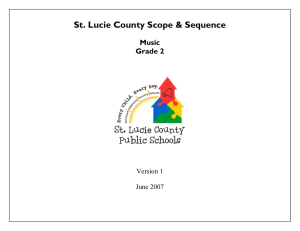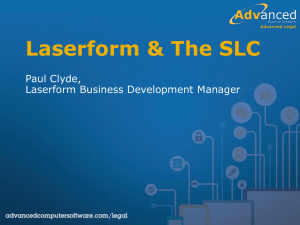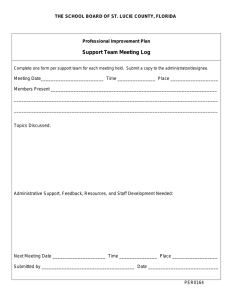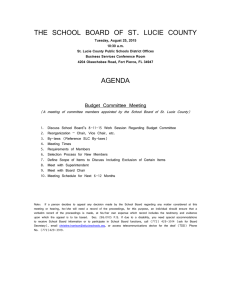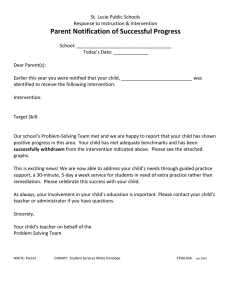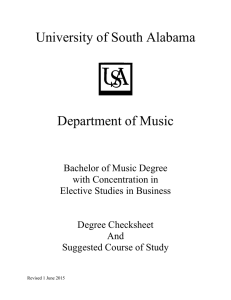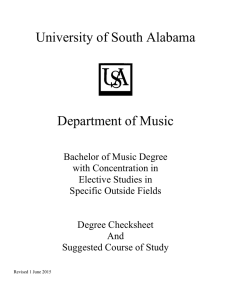St. Lucie County Scope & Sequence Music Grade 3
advertisement
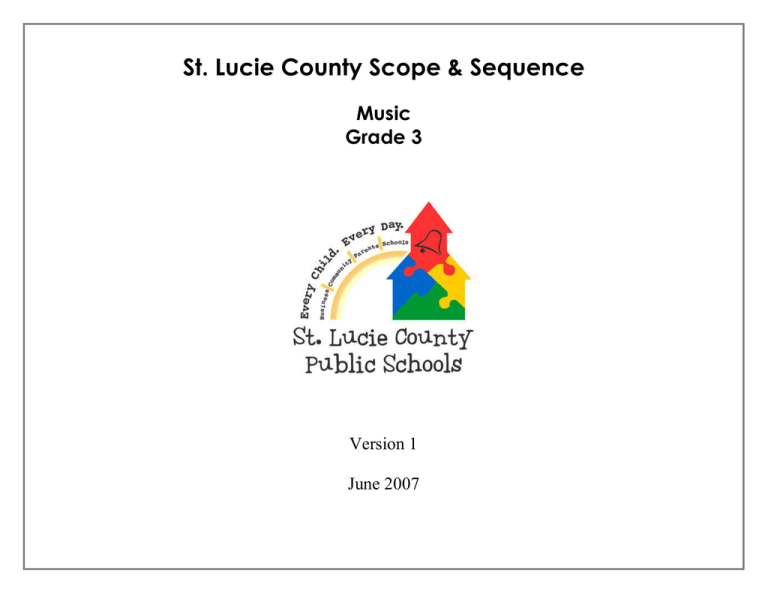
St. Lucie County Scope & Sequence Music Grade 3 Version 1 June 2007 The Sunshine State Standards (SSS), approved in 1996, provide expectations for student achievement in Florida. The SSS are written in subject areas and divided into four separate grade clusters. Benchmarks are written for each grade cluster to define the specific content for each standard. As Florida has moved toward greater accountability for student learning and achievement, these benchmarks are the basis for state assessments: Florida Comprehensive Assessment Test (FCAT) and Norm Reference Test (NRT). St. Lucie County (SLC) has developed a tool that links the SSS to our local curriculum. This tool is the SLC Scope and Sequence, the content and substance of the district curriculum. It supports students’ efforts to master the Benchmarks tested on the FCAT and NRT. The SLC Scope & Sequence is divided into elementary, middle, and high school levels. Within each level, it is subdivided into subject areas: Math, Reading/Language Arts, Science, and Social Studies according to grade levels and nine week periods. The document contains Essential Questions that organize the content and skills for student learning. The Scope and Sequence supports the District’s belief that “Every child can learn and each child can learn more than he or she is now learning.” The implementation of the Scope & Sequence provides equity of access to quality curriculum content for all students and is intended to prevent gaps in students’ learning due to student mobility. The SLC Scope & Sequence can be found at http://www.stlucie.k12.fl.us/slcsbnet/index.aspx The SLC Scope & Sequence is the basis for the St. Lucie Standardized Benchmark Assessment System and determines what benchmarks should be learned and will be tested each nine weeks. St. Lucie Standardized Benchmark Assessment System These tests are designed to monitor the progress of students’ mastery of the tested Benchmarks on the FCAT in reading, math, and science as aligned to the SLC Scope & Sequence in these subject areas. The Benchmark tests are given throughout the year to students in grades 3-10 in reading and math and grades 3-11 in science. The data from the performance of students on these tests will be used by teachers to guide instruction and assist administrators in monitoring the growth in student learning within classrooms, grade levels, and school sites. Content of the SLC Scope & Sequence Document Format: divided into each nine week period; lists the content and skills for the subject area and grade level, along with suggested resource materials; lists the coordinating SSS Benchmark indicates Introduce (I), Reinforce (R), Master (M) levels SLC Scope & Sequence Music Ver. 1 June 2007 Essential Questions: aligned to the SSS benchmarks; organize the content & skills for each nine week period; determine what is critical to learn 1 Working on the Work (WOW) Connections A St. Lucie County district initiative, WOW is a framework for designing lessons to engage more of the students more of the time. WOW lessons are built on 10 design qualities. One of these design qualities, Content and Substance, identifies the essential knowledge and skills that students must master. The St. Lucie County Scope and Sequence is the content and substance of the district’s curriculum. The CORE business of St. Lucie County Schools is to create challenging, engaging and satisfying work for every student, every day. The SLC Scope & Sequence was developed by the Curriculum Specialists, Teaching and Learning & Title I Department, with teams of St. Lucie County teachers. SLC Scope & Sequence Music Ver. 1 June 2007 2 Subject Area: Music Grade 3 Content & Substance Organization of Knowledge Sunshine State Standards Addressed & Mastery Level Indicator What students will know and be able to do Recommended Lessons with Supporting Resources Introduce - I Reinforce - R Master - M Essential Questions 1st 9 weeks How can I use my voice to sing alone and with others? Content Vocal Technique Sings melodic patterns and songs, matching pitch, with and extended range (E-E1.) (I) Demonstrates healthy singing techniques, including posture, breath support, voice placement, and unified vowels. (I) Sings unison songs and ostinati, (I) with and without accompaniment, using accurate pitch and rhythm. (R) Vocal Application What do I use my voice to reflect the style, culture, genre and period of a song? Vocal Expression SLC Scope & Sequence Music Ver. 1 June 2007 Assessment Skills Echoes simple melodic patterns using sol, la, mi, re do. (I) How can I use my voice to sing alone and with others? Clear & Compelling Standards Sings, with stylistic (I) accuracy, a diverse repertoire representing various cultures, historical periods, and genres. Sings with expression and style (I)appropriate to the music performed. MUA 1.2.1 MUA 1.2.1 MUA 1.2.1 R MUA 1.2.1 R MUA 1.2.2 R MUA 1.2.3 3 Subject Area: Music Grade 3 Content & Substance Organization of Knowledge Sunshine State Standards Addressed & Mastery Level Indicator What students will know and be able to do Recommended Lessons with Supporting Resources Introduce - I Reinforce - R Master - M Essential Questions 1st 9 weeks When I sing, how do I blend my voice with others? When playing instruments, how do I play accompaniments? Content Vocal Ensemble Technique Sings with others, blending vocal timbres and matching dynamic levels. Instrumental Technique Performs rhythmic, melodic, and harmonic instrumental accompaniments. Instrumental Application Performs on pitched and non-pitched instruments, a diverse repertoire representing various cultures, historical periods, and genres. Performs on classroom and ethnic instruments with expression and style (I) appropriate to the music. How do I choose the best instrument to go with the song I am singing or listening to? SLC Scope & Sequence Music Ver. 1 Instrumental Application: Echoing June 2007 Assessment Skills Produces a characteristic instrumental tone using appropriate performance techniques (i.e. breath support, posture, hand position.) How do I choose the best instrument to go with the song I am singing or listening to? Clear & Compelling Standards Echoes short rhythmic phrases on nonpitched instruments. I MUA 1.2.4 R MUA 2.2.1 R MUA 2.2.1 I MUA 2.2.2 R MUA 2.2.2 R MUA 2.2.4 4 Subject Area: Music Grade 3 Content & Substance Organization of Knowledge Sunshine State Standards Addressed & Mastery Level Indicator What students will know and be able to do Recommended Lessons with Supporting Resources Introduce - I Reinforce - R Master - M Essential Questions Content Clear & Compelling Standards Assessment Skills 1st 9 weeks How does notation represent what I hear and play? Sight reads rhythm patterns, including quarter notes, quarter rests, eighth notes, half notes, half rests, whole notes, whole rests in duple meter (I). Notation Interprets music symbols and terms in repertoire that refer to dynamics, tempo, articulation, and expression (i.e. piano, allegro, staccato) when performing. Notation What do I listen for to classify the music I hear When I listen to music how do I identify the parts that make it unique? What music vocabulary words can I use to describe the music I play, sing and hear? SLC Scope & Sequence Music Ver. 1 Cultural and Historical Connections Critical Analysis: Form Critical Analysis: Vocabulary Application June 2007 Classifies selected exemplary works by selected genre (i.e. folk song,) style (i.e. popular jazz,) and composer. Compares rhythm, timbre, and expressive devices of contrasting examples of world music. Listens to and analyzes a composition to identify meter (duple or triple) or form (i.e. verse-refrain, call-and- response, AB, ABA.) Describes a variety of world music using appropriate vocabulary (i.e. vocal quality, instrumentation, rhythmic/melodic patterns.) R MUA 3.2.1 I MUA 3.2.2 I MUC 1.2.1 I MUC 1.2.2 I MUD 1.2.1 I MUE 1.2.1 5 Subject Area: Music Grade 3 Content & Substance Organization of Knowledge Sunshine State Standards Addressed & Mastery Level Indicator What students will know and be able to do Recommended Lessons with Supporting Resources Introduce - I Reinforce - R Master - M Essential Questions Content Clear & Compelling Standards Assessment Skills 1st 9 weeks How are the subjects I study in my classroom related to my studies of music? Application to Life: Cross-Curricular Connections Describes ways in which the subject matter of other disciplines is related to music (i.e. rhythmic and numeric patterns in music and mathematics.) When I attend a performance how should I behave depending on the type of performance? Application to Life: Audience Etiquette Demonstrates audience behavior appropriate to the context, setting, and style of music performed (i.e. pep band performance at a sporting event.) Why should I listen to music I don’t really like? What types of jobs might I get if I decide to be a musician? Application to Life: Music Appreciation Application to Life: Roles of Musicians Respects differing values and tastes in music. SLC Scope & Sequence Music Ver. 1 June 2007 Identifies the roles and importance of musicians in various settings and cultures. I MUE 1.2.2 I MUE 2.2.2 I MUE 2.2.3 R MUE 2.2.4 6
